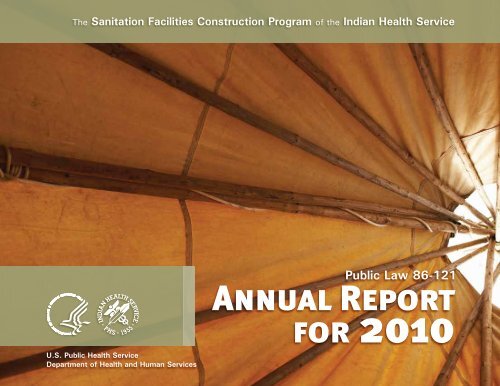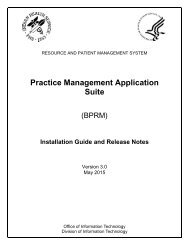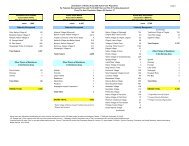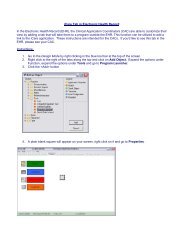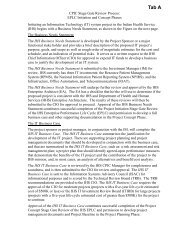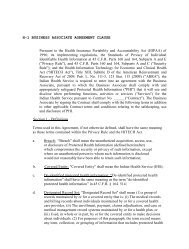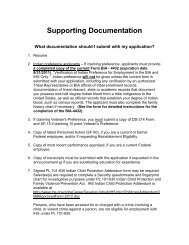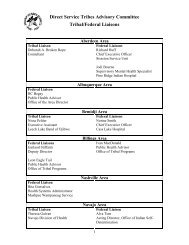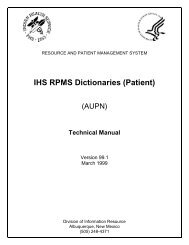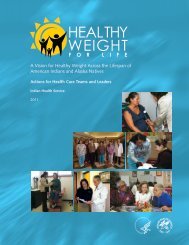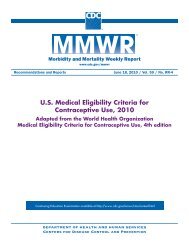Public Law 86-121 Annual Report for 2010 - Indian Health Service
Public Law 86-121 Annual Report for 2010 - Indian Health Service
Public Law 86-121 Annual Report for 2010 - Indian Health Service
Create successful ePaper yourself
Turn your PDF publications into a flip-book with our unique Google optimized e-Paper software.
The Sanitation Facilities Construction Program of the <strong>Indian</strong> <strong>Health</strong> <strong>Service</strong><br />
U.S. <strong>Public</strong> <strong>Health</strong> <strong>Service</strong><br />
Department of <strong>Health</strong> and Human <strong>Service</strong>s<br />
<strong>Public</strong> <strong>Law</strong> <strong>86</strong>-<strong>121</strong><br />
<strong>Annual</strong> <strong>Report</strong><br />
<strong>for</strong> <strong>2010</strong>
This <strong>Annual</strong> <strong>Report</strong> <strong>for</strong> Fiscal Year <strong>2010</strong> was produced by the <strong>Indian</strong> <strong>Health</strong> <strong>Service</strong><br />
Sanitation Facilities Construction Program to make available frequently requested<br />
in<strong>for</strong>mation about the Program. Additional in<strong>for</strong>mation can be obtained by writing<br />
to the following address:<br />
Website: www.dsfc.ihs.gov<br />
Editor: Carol L. Rogers, P.E.<br />
<strong>Indian</strong> <strong>Health</strong> <strong>Service</strong><br />
Sanitation Facilities Construction Program<br />
12300 Twinbrook Parkway<br />
Room 610, Twinbrook Metro Plaza<br />
Rockville, MD 20852<br />
Mention of trade names or commercial products does not constitute endorsement<br />
or recommendation <strong>for</strong> use.<br />
The Sanitation Facilities Construction Program of the <strong>Indian</strong> <strong>Health</strong> <strong>Service</strong> • <strong>Public</strong> <strong>Law</strong> <strong>86</strong>-<strong>121</strong> <strong>Annual</strong> <strong>Report</strong> <strong>for</strong> <strong>2010</strong><br />
c
The Sanitation Facilities Construction Program<br />
<strong>Annual</strong> <strong>Report</strong> <strong>for</strong> <strong>2010</strong> <br />
Table of Contents<br />
Preface............................................................................................................................................ iii<br />
Introduction ....................................................................................................................................1<br />
The SFC Program Mission ............................................................................................................2<br />
Tribal Involvement.........................................................................................................................3<br />
“The Year” in Review....................................................................................................................5<br />
Big Bend Lift Station, South Dakota ..............................................................................8<br />
Gulkana Community Lagoon, Alaska.............................................................................9<br />
Laguna Mesita Water Storage Tank, New Mexico.......................................................10<br />
Lac Du Flambeau Water System Improvement, Wisconsin.......................................11<br />
Brockton Lagoon Bank Stabilization, Montana ...........................................................12<br />
Yurok Water Monitoring, Cali<strong>for</strong>nia..............................................................................13<br />
Round Rock Waterline Extension, Arizona ................................................................14<br />
Yellowhill Leaking Water Storage Tank, North Carolina ...........................................15<br />
Vance Springs Water Treatment Plant, Oklahoma ......................................................16<br />
Whiteriver Surface Water Treatment Plant, Arizona...................................................17<br />
Lower Elwha Valley Water Storage, Washington ........................................................18<br />
Sells Community Sewage Lift Station, Arizona ...........................................................19<br />
Sanitation Facilities and <strong>Health</strong> .................................................................................................20<br />
Program Operations ....................................................................................................................22<br />
Sanitation Deficiencies ................................................................................................................28<br />
The Challenge Ahead ..................................................................................................................40<br />
IHS Area SFC Program Directory..............................................................................................41<br />
The Sanitation Facilities Construction Program of the <strong>Indian</strong> <strong>Health</strong> <strong>Service</strong> • <strong>Public</strong> <strong>Law</strong> <strong>86</strong>-<strong>121</strong> <strong>Annual</strong> <strong>Report</strong> <strong>for</strong> <strong>2010</strong><br />
i
Preface<br />
The <strong>Indian</strong> <strong>Health</strong> <strong>Service</strong> (IHS) Sanitation Facilities Construction (SFC) Program<br />
continues to identify and report the sanitation needs of American <strong>Indian</strong>s and Alaska<br />
Natives while carrying out a Program to meet those needs in cooperation with tribal<br />
governments. Those needs are summarized in this report as well as some of the<br />
accomplishments of the Program during the reported fiscal year. The Program’s<br />
continuing challenges include improving community water supplies, waste water<br />
treatment systems, and solid waste disposal facilities in culturally diverse and often<br />
times remote areas--from Alaska to Florida and from Maine to Cali<strong>for</strong>nia. The projects<br />
highlighted in this report illustrate typical SFC Program ef<strong>for</strong>ts in addressing these<br />
specific challenges.<br />
Since the passage of <strong>Public</strong> <strong>Law</strong> <strong>86</strong>-<strong>121</strong> in 1959, the SFC Program has worked in<br />
partnership with tribal governments to construct essential sanitation facilities. As a result<br />
of over 51 years of cooperative ef<strong>for</strong>ts, many tribes have developed the administrative and<br />
technical capability to construct their own sanitation facilities with engineering support<br />
from IHS. The majority of all the SFC Program’s construction work is accomplished<br />
by either tribes, tribal organizations or <strong>Indian</strong>-owned construction firms. A number of<br />
tribes continue to assume responsibility <strong>for</strong> their respective SFC programs, while the SFC<br />
Program continues to work with tribes and others to support the tribal Self-Governance/<br />
Self-Determination decision making process under the authority of the <strong>Indian</strong> Self-<br />
Determination and Education Assistance Act. One goal of the SFC Program is to make<br />
available program in<strong>for</strong>mation in a more open, accurate, and effcient way; this report,<br />
prepared annually since 1993, is one means of achieving that goal.<br />
The Sanitation Facilities Construction Program of the <strong>Indian</strong> <strong>Health</strong> <strong>Service</strong> • <strong>Public</strong> <strong>Law</strong> <strong>86</strong>-<strong>121</strong> <strong>Annual</strong> <strong>Report</strong> <strong>for</strong> <strong>2010</strong><br />
iii
Introduction<br />
On July 31, 1959, President Dwight D. Eisenhower signed <strong>Public</strong> <strong>Law</strong> (P.L.) <strong>86</strong>-<strong>121</strong>.<br />
Under this Act, the Surgeon General is authorized to construct essential sanitation<br />
facilities <strong>for</strong> American <strong>Indian</strong> and Alaska Native homes and communities. Since 1959,<br />
over 361,000 homes have been provided sanitation facilities and this achievement has<br />
had a significant impact on the health of Native Americans. The gastroenteric and postneonatal<br />
death rates among the <strong>Indian</strong> people have been reduced significantly, primarily<br />
because of the increased prevalence of safe drinking water supplies and sanitary waste<br />
disposal systems.<br />
The authority vested in the Surgeon General by P.L. <strong>86</strong>-<strong>121</strong> was transferred to the<br />
Secretary, <strong>Health</strong>, Education, and Welfare (HEW), by Reorganization Plan No. 3 of 1966.<br />
The Secretary of HEW was re-designated Secretary of <strong>Health</strong> and Human <strong>Service</strong>s by<br />
Section 509(b) of P.L. 96-88 in 1979. The authority was delegated to the Director, <strong>Indian</strong><br />
<strong>Health</strong> <strong>Service</strong>, by the Reorganization Order of January 4, 1988 (52 FR 47053), which<br />
elevated the IHS to a <strong>Public</strong> <strong>Health</strong> <strong>Service</strong> (PHS) Agency.<br />
The Sanitation Facilities Construction (SFC) Program is unusual among Federal<br />
programs because IHS personnel work cooperatively, as close partners, with tribes<br />
in providing essential sanitation facilities to <strong>Indian</strong> communities and Alaska villages.<br />
Enhancing tribal capabilities and building partnerships based on mutual respect are the<br />
major keys to the success of the SFC Program.<br />
Protecting the health of and preventing disease among American <strong>Indian</strong> and<br />
Alaska Native populations are primary IHS objectives. In the clinical environment,<br />
physicians, dentists, nurses, and other medical care providers work to restore the<br />
health of ill patients. However, preventing illness is clearly the most effective way to<br />
improve health status. Improving the environment in which people live and assisting<br />
them to interact positively with that environment results in significantly healthier<br />
populations. Providing sanitation facilities and better quality housing are environmental<br />
improvements that have proven track records in that regard.<br />
The Sanitation Facilities Construction Program of the <strong>Indian</strong> <strong>Health</strong> <strong>Service</strong> • <strong>Public</strong> <strong>Law</strong> <strong>86</strong>-<strong>121</strong> <strong>Annual</strong> <strong>Report</strong> <strong>for</strong> <strong>2010</strong><br />
1
The SFC Program Mission<br />
Today, as it has <strong>for</strong> over 51 years, the SFC Program continues to provide assistance<br />
to the American <strong>Indian</strong> and Alaska Native people in eliminating sanitation facilities<br />
deficiencies in <strong>Indian</strong> homes and communities.<br />
The IHS mission is to raise the health status of American <strong>Indian</strong> and Alaska Native<br />
people to the highest possible level. To carry out its mission, the IHS provides<br />
comprehensive primary and preventive health services. The SFC Program supports the<br />
IHS’s mission by providing engineering, technical, and financial assistance to <strong>Indian</strong><br />
tribes and Alaska Native villages (tribes) <strong>for</strong> cooperative development and continued<br />
operation of safe water, wastewater, and solid waste systems and related support<br />
facilities. In partnership with the tribes, the SFC Program:<br />
1. Develops and maintains an inventory of sanitation deficiencies in <strong>Indian</strong><br />
and Alaska Native communities <strong>for</strong> use by IHS and to in<strong>for</strong>m Congress.<br />
2. Provides environmental engineering assistance with utility master planning<br />
and sanitary surveys.<br />
3. Develops multi-agency funded sanitation projects; accomplishes interagency<br />
coordination; assist with grant applications; and leverages IHS funds.<br />
4. Provides funding <strong>for</strong> water supply and waste disposal facilities.<br />
5. Provides professional engineering design and/or construction services <strong>for</strong><br />
water supply and waste disposal facilities.<br />
6. Provides technical consultation and training to improve the operation and<br />
maintenance of tribally owned water supply and waste disposal systems.<br />
7. Advocates <strong>for</strong> tribes during the development of policies, regulations, and programs.<br />
Homeowner Training, 1960’s.<br />
8. Assists tribes with sanitation facility emergencies.<br />
2<br />
The Sanitation Facilities Construction Program of the <strong>Indian</strong> <strong>Health</strong> <strong>Service</strong> • <strong>Public</strong> <strong>Law</strong> <strong>86</strong>-<strong>121</strong> <strong>Annual</strong> <strong>Report</strong> <strong>for</strong> <strong>2010</strong>
Tribal Involvement<br />
The SFC Program employs a cooperative approach <strong>for</strong> providing sanitation<br />
facilities to American <strong>Indian</strong> and Alaska Native communities. During fiscal<br />
year (FY) <strong>2010</strong>, tribes, tribal organizations or <strong>Indian</strong>-owned construction<br />
firms administered approximately $136 million in construction funds. Many<br />
tribes participated by contributing labor, materials, and administrative<br />
support to projects.<br />
Each sanitation facilities construction project is initiated at the request of<br />
a tribe or tribal organization. Consultation with the tribal government<br />
is maintained throughout every phase of the construction process, from<br />
preliminary design to project completion. Operation and maintenance of<br />
these facilities by the American <strong>Indian</strong> and Alaska Native people, with<br />
ongoing technical assistance from IHS, ensures the long-term health benefits<br />
associated with improved sanitation conditions. In addition to construction<br />
work, a number of tribes assumed responsibility <strong>for</strong> the administration of<br />
their own SFC Program. Under Titles I and V of P.L. 93-638, the <strong>Indian</strong><br />
Self-Determination and Education Assistance Act, as amended, tribes from<br />
the Anchorage, Billings, Cali<strong>for</strong>nia, Nashville, Oklahoma City and Phoenix<br />
Areas are managing their own SFC Program through Self-Governance<br />
compacts. (Table 1 on the following page).<br />
Fund Expended<br />
(millions)<br />
$30<br />
$25<br />
$20<br />
$15<br />
$10<br />
$5<br />
$0<br />
Sanitation Facilities Construction<br />
by <strong>Indian</strong> Tribes and Firms, FY <strong>2010</strong><br />
AB AL AN BE BI CA NS NA OK PH PO TU<br />
Area<br />
638/compact BUY INDIAN MOA<br />
Funds expended by <strong>Indian</strong> and Alaska Native tribes and<br />
<strong>Indian</strong>-owned firms in FY <strong>2010</strong>, by IHS Area.<br />
The IHS, SFC Program seeks the advice and recommendations of the<br />
national Facilities Appropriation Advisory Board and Area-specific<br />
Tribal Advisory Committees. These groups review program policies and<br />
guidelines and provide input on the future direction of the SFC program.<br />
Lift station operations and maintenance course offered<br />
in Ferndale, Washington.<br />
The Sanitation Facilities Construction Program of the <strong>Indian</strong> <strong>Health</strong> <strong>Service</strong> • <strong>Public</strong> <strong>Law</strong> <strong>86</strong>-<strong>121</strong> <strong>Annual</strong> <strong>Report</strong> <strong>for</strong> <strong>2010</strong><br />
3
600,000 gallon pre-stressed concrete water storage,<br />
Sandia Pueblo, New Mexico.<br />
* Title I<br />
TABLE 1<br />
Tribes that Managed the SFC Program in FY <strong>2010</strong><br />
Under Title I or V of P.L. 93-638, as Amended<br />
IHS Area<br />
Anchorage<br />
Billings<br />
Cali<strong>for</strong>nia<br />
Nashville<br />
Navajo<br />
Oklahoma City<br />
Phoenix<br />
Tribe<br />
Alaska Native Tribal <strong>Health</strong> Consortium<br />
Confederated Tribes of Salish & Kootenai<br />
(Flathead)<br />
Rocky Boys (Chippewa-Cree)<br />
Hoopa Valley Tribe<br />
Chitmacha Tribe of Louisiana<br />
Mississippi Band of Choctaw <strong>Indian</strong>s<br />
St. Regis Mohawk<br />
Eastern Band of Cherokee<br />
* Navajo Nation<br />
Cherokee Nation of Oklahoma<br />
Absentee Shawnee Tribe of Oklahoma<br />
Choctaw Nation of Oklahoma<br />
Chickasaw Nation of Oklahoma<br />
Wyandotte Tribe of Oklahoma<br />
* Modoc Tribe of Oklahoma<br />
The Seminole Nation of Oklahoma<br />
(in Chickasaw Compact)<br />
Ely Shoshone Tribe<br />
* Gila River Pima-Maricopa <strong>Indian</strong> Community<br />
Yerington<br />
4<br />
The Sanitation Facilities Construction Program of the <strong>Indian</strong> <strong>Health</strong> <strong>Service</strong> • <strong>Public</strong> <strong>Law</strong> <strong>86</strong>-<strong>121</strong> <strong>Annual</strong> <strong>Report</strong> <strong>for</strong> <strong>2010</strong>
“The Year” in Review<br />
In FY <strong>2010</strong>, over $95 million was appropriated <strong>for</strong> the construction of sanitation facilities.<br />
In addition to those appropriated funds, the SFC Program received more than $161<br />
million in contributions from other Federal agencies including the Environmental<br />
Protection Agency (EPA) and from non-Federal sources such as tribes and State agencies.<br />
With these contributions, the SFC Program’s construction budget <strong>for</strong> the fiscal year<br />
totaled more than $256 million.<br />
Using the appropriated and contributed funds, the SFC Program initiated 427 projects<br />
to provide essential sanitation facilities to an estimated 1,933 new and like-new homes,<br />
2,204 existing first service homes and 14,502 existing homes. The new housing units<br />
provided with sanitation facilities included 203 HUD-sponsored units (served with<br />
contributed funds), 125 Bureau of <strong>Indian</strong> Affairs-Home Improvement Program (BIA-<br />
HIP) sponsored units, and 1,605 units constructed by tribes, individuals, and other<br />
entities. In FY <strong>2010</strong>, the SFC Program provided sanitation facilities to a total of 18,639<br />
homes. These statistics are summarized in Table 2 on the following page.<br />
Sanitation Facilities Construction<br />
FY <strong>2010</strong> Appropriations Distribution by Area<br />
Sanitation Facilities Construction<br />
FY <strong>2010</strong> Funding Distribution by Area<br />
$30<br />
$50<br />
Amount of Funding<br />
(millions)<br />
$20<br />
$10<br />
Amount of Funding<br />
(millions)<br />
$40<br />
$30<br />
$20<br />
$10<br />
$0<br />
AB AL AN BE BI CA NS NA OK PH PO TU<br />
Fiscal Year<br />
$0<br />
AB AL AN BE BI CA NS NA OK PH PO TU<br />
Fiscal Year<br />
Special/Emergency Regular Bulk Housing<br />
Contributions<br />
IHS Funds<br />
Distribution of SFC Project appropriations, by Area, <strong>for</strong> FY <strong>2010</strong>. Total distribution of SFC Project funds in FY <strong>2010</strong>,<br />
including all contributions and HUD funds.<br />
The Sanitation Facilities Construction Program of the <strong>Indian</strong> <strong>Health</strong> <strong>Service</strong> • <strong>Public</strong> <strong>Law</strong> <strong>86</strong>-<strong>121</strong> <strong>Annual</strong> <strong>Report</strong> <strong>for</strong> <strong>2010</strong><br />
5
TABLE 2<br />
IHS Sanitation Facilities Construction Program Statistics <strong>for</strong> FY <strong>2010</strong><br />
SFC Program Budget:<br />
IHS SFC Appropriation = $95,857,000<br />
HUD Contributions (Housing + CDBG*) = $2,236,553<br />
Homes Provided Sanitation Facilities since 1959:<br />
• Number of New and Like-New Homes<br />
HUD-sponsored Homes = 61,<strong>86</strong>1<br />
Other Contributions = $161,739,791<br />
Total Funding in FY 2007 = $239,711,703<br />
BIA-sponsored Homes = 23,337<br />
Tribal and Other Homes = 84,021<br />
Total IHS SFC Appropriations since 1959 =<br />
SFC Projects:<br />
$2.7 billion<br />
Subtotal 169,221<br />
• Number of First <strong>Service</strong> Existing Homes = 123,559<br />
Total Number of Homes Served = 276,906<br />
Number of Projects Undertaken in <strong>2010</strong> = 427<br />
Total Number of Projects Undertaken since 1959 = 14,855<br />
Sanitation Deficiency System (SDS) In<strong>for</strong>mation:<br />
Total Estimated Cost of Sanitation Deficiencies =<br />
$2.9 billion<br />
Homes Provided Sanitation Facilities in FY <strong>2010</strong>:<br />
• Number of New and Like-New Homes Served<br />
HUD-sponsored Homes = 204<br />
BIA-sponsored Homes = 125<br />
Total Estimated Cost of Feasible Projects =<br />
Total Number of Projects/Phases Identified = 3,439<br />
Number of Feasible Projects Identified = 2,638<br />
Tribal and Other Homes = 1,605<br />
Subtotal 1,934<br />
• Number of Existing First <strong>Service</strong> Homes Served = 2,203<br />
•<br />
Number of Previously Served Homes<br />
Provided Upgraded Sanitation Facilities = 14,502<br />
Total Number of Homes Served in 2007 = 18,639<br />
Estimated Total Number of Existing Homes<br />
Without Potable Water = 34,187<br />
Estimated Total Number of Homes That Lack<br />
Either a Safe Water Supply or Sewage Disposal<br />
System, or Both (Deficiency Levels 4 and 5) = 46,392<br />
*CDBG-HUD Community Development Block Grant program<br />
6<br />
The Sanitation Facilities Construction Program of the <strong>Indian</strong> <strong>Health</strong> <strong>Service</strong> • <strong>Public</strong> <strong>Law</strong> <strong>86</strong>-<strong>121</strong> <strong>Annual</strong> <strong>Report</strong> <strong>for</strong> <strong>2010</strong>
Twelve sanitation facilities construction projects are highlighted on the following pages.<br />
These projects represent a small fraction of the total construction workload undertaken<br />
by the SFC Program. They were selected to illustrate typical cooperative ef<strong>for</strong>ts<br />
undertaken by IHS, the tribes, and other Federal and state agencies to provide safe water<br />
supply, sanitary sewage disposal, and solid waste facilities <strong>for</strong> American <strong>Indian</strong> and<br />
Alaska Native homes and communities.<br />
500k water tank construction,<br />
Sweetwater, Arizona.<br />
Steel water tank construction, <br />
Sweetwater, Arizona.<br />
Completed 500k water tank construction,<br />
Sweetwater, Arizona.<br />
The Sanitation Facilities Construction Program of the <strong>Indian</strong> <strong>Health</strong> <strong>Service</strong> • <strong>Public</strong> <strong>Law</strong> <strong>86</strong>-<strong>121</strong> <strong>Annual</strong> <strong>Report</strong> <strong>for</strong> <strong>2010</strong> 7
Existing lift station.<br />
Big Bend Lift Station<br />
Crow Creek Reservation, South Dakota<br />
Renovated lift system.<br />
The Crow Creek Reservation is located in central South<br />
Dakota in the Aberdeen Area IHS. The Big Bend community<br />
lift station had problems with the variable frequency drives<br />
and the pumps. Both pumps had failed, and the system was<br />
operating with a single temporary pump. In addition, the<br />
concrete surrounding the lift stations needed to be repaired.<br />
Several alternatives were considered but the renovation<br />
alternative was selected. The renovation included two<br />
new pumps with new guide rails and electrical drives, new<br />
gate valves, new check valves, new concrete pad, wetwell<br />
improvements, and access hatch replacement. This project<br />
served 24 American <strong>Indian</strong> homes.<br />
Exterior of the renovated lift station building.<br />
8<br />
The Sanitation Facilities Construction Program of the <strong>Indian</strong> <strong>Health</strong> <strong>Service</strong> • <strong>Public</strong> <strong>Law</strong> <strong>86</strong>-<strong>121</strong> <strong>Annual</strong> <strong>Report</strong> <strong>for</strong> <strong>2010</strong>
Gulkana Community Lagoon<br />
Gulkana, Alaska<br />
The Gulkana community wastewater was being dumped<br />
directly into the Gulkana River without treatment due to<br />
cracked septic tanks and and community drainfield failure.<br />
A geotechnical consultant was employed to research the<br />
possible failure of the community drainfield and concluded<br />
that the site was generally adequate <strong>for</strong> the siting of<br />
the drainfield.<br />
Removal of soil to complete the lagoon.<br />
Placement of septic tanks.<br />
The project modified the existing design of the community<br />
system and reconstruct the system with a community lagoon<br />
and replacement of the two septic tanks. This project served<br />
31Alaska Native homes.<br />
Construction to complete the lagoon.<br />
The Sanitation Facilities Construction Program of the <strong>Indian</strong> <strong>Health</strong> <strong>Service</strong> • <strong>Public</strong> <strong>Law</strong> <strong>86</strong>-<strong>121</strong> <strong>Annual</strong> <strong>Report</strong> <strong>for</strong> <strong>2010</strong><br />
9
Laguna Mesita Water Storage Tank<br />
Pueblo of Laguna, New Mexico<br />
The old water storage tank, serving the Village of Mesita,<br />
was not large enough to meet current storage volume design<br />
standards. Water did not circulate properly in the tank due<br />
to the location and elevation of the water tank, and it could<br />
not hydraulically feed a large part of the community.<br />
Construction of the water distribution line.<br />
Clearing the right of way and rock excavation <strong>for</strong> the tank.<br />
A new storage tank was built and 5,685 feet of 8-inch PVC<br />
waterline was installed to connect the new storage tank<br />
to its water source. An altitude valve was installed at the<br />
tank inlet to control the tank’s filling cycle. The dedicated<br />
waterline and separate tank inlet provides a more stable and<br />
controlled water system <strong>for</strong> the community of 210 American<br />
<strong>Indian</strong> homes.<br />
Separate waterline and tank piping.<br />
10<br />
The Sanitation Facilities Construction Program of the <strong>Indian</strong> <strong>Health</strong> <strong>Service</strong> • <strong>Public</strong> <strong>Law</strong> <strong>86</strong>-<strong>121</strong> <strong>Annual</strong> <strong>Report</strong> <strong>for</strong> <strong>2010</strong>
Soil compaction in the waterline trench.<br />
Right of way <strong>for</strong> the waterline.<br />
Lac Du Flambeau Water System Improvements<br />
Lac Du Flambeau, Wisconsin<br />
Existing homes throughout the Lac du Flambeau Band of<br />
Lake Superior Chippewa <strong>Indian</strong>s needed water system<br />
improvements. To address the need 8-inch and 10-inch PE<br />
and PVC water main pipe and associated appurtenances were<br />
installed to replace a deficient existing water main, to connect<br />
dead end water mains on Little Pines Road. To connect the<br />
Fence Lake community via directional drilling and open-cut<br />
excavation was required.<br />
Over 4,000 feet of 8-inch and 3,400 feet of 10-inch water main<br />
pipe were installed. All project funding was provided by<br />
the Environmental Protection Agency Safe Drinking Water<br />
program. This project served 147 American <strong>Indian</strong> homes.<br />
Testing the fire hydrant.<br />
The Sanitation Facilities Construction Program of the <strong>Indian</strong> <strong>Health</strong> <strong>Service</strong> • <strong>Public</strong> <strong>Law</strong> <strong>86</strong>-<strong>121</strong> <strong>Annual</strong> <strong>Report</strong> <strong>for</strong> <strong>2010</strong><br />
11
The lagoon be<strong>for</strong>e the repair<br />
Erosion at the fence of the wastewater lagoon.<br />
Brockton Lagoon Bank Stabilization<br />
Fort Peck Reservation, Montana<br />
The embankment of the existing wastewater lagoon is eroding and several areas<br />
are vertical and under cut by the erosion. Wind erosion could wash out the banks<br />
during times of high water depths in the cell. In the spring the City of Brockton<br />
has to hold water at high levels to ensure that treatment has occurred be<strong>for</strong>e<br />
discharging in order to meet the NPDES requirements.<br />
There are areas where the dike width has eroded to less than 10’ adjacent to a<br />
drainage channel and is most susceptible to erosion due to prevailing winds.<br />
The lagoon system is adjacent to the Missouri River and may present a threat to<br />
downstream individual and community water users. Continued erosion may<br />
cause dike failure within 3 years. This project served 94 American <strong>Indian</strong> homes.<br />
Reconstruction of the embankment.<br />
12<br />
The Sanitation Facilities Construction Program of the <strong>Indian</strong> <strong>Health</strong> <strong>Service</strong> • <strong>Public</strong> <strong>Law</strong> <strong>86</strong>-<strong>121</strong> <strong>Annual</strong> <strong>Report</strong> <strong>for</strong> <strong>2010</strong>
Moitoring equipment inside the pump.<br />
Solar power generation equipment.<br />
Yurok Water Monitoring<br />
Yurok Tribe of Cali<strong>for</strong>nia, Cali<strong>for</strong>nia<br />
The project provided water improvements to the Wautec<br />
and Weitchpec water treatment systems. The improvements<br />
included solar panels with batteries, satellite radio<br />
transmitters, monitoring equipment, turbidimeters,<br />
pressure transducers, and data loggers. There were also <br />
improvements made to the equipment housing. This project <br />
served 44 American <strong>Indian</strong> homes.<br />
4-20mA water level indicator.<br />
The Sanitation Facilities Construction Program of the <strong>Indian</strong> <strong>Health</strong> <strong>Service</strong> • <strong>Public</strong> <strong>Law</strong> <strong>86</strong>-<strong>121</strong> <strong>Annual</strong> <strong>Report</strong> <strong>for</strong> <strong>2010</strong><br />
13
Construction of the waterline trench.<br />
Clearing of the right of way <strong>for</strong> the waterline project.<br />
Round Rock Waterline Extension<br />
Round Rock, Arizona<br />
The Round Rock Chapter of the Navajo Nation requested<br />
assistance <strong>for</strong> waterline extensions to homes in the Round<br />
Rock area. This project constructed over 32,000 feet of 4-inch<br />
PVC waterline pipe while another IHS project installed<br />
20,000 feet of 2-inch pipe and septic tank/ drainfield systems. <br />
This project served 38 American <strong>Indian</strong> homes.<br />
Installation of a septic tank drainfield system.1<br />
14<br />
The Sanitation Facilities Construction Program of the <strong>Indian</strong> <strong>Health</strong> <strong>Service</strong> • <strong>Public</strong> <strong>Law</strong> <strong>86</strong>-<strong>121</strong> <strong>Annual</strong> <strong>Report</strong> <strong>for</strong> <strong>2010</strong>
Leaking Yellowhill Water Leaking Storage Water Tank Storage Tank<br />
Yellowhill Community, North Carolina<br />
The water storage tank located in the Yellowhill<br />
community of the Eastern Band of Cherokee Reservations<br />
has been leaking since 2005. Several attempts at repairing<br />
the leak had failed. It was determined that the only way<br />
to fix the leak was to dismantle the water storage tank,<br />
remove the foundation, build a new foundation, and<br />
re-erect the water storage tank. This project served 1,825<br />
American <strong>Indian</strong> homes.<br />
Erection of the water storage tank.<br />
Leaking at the water storage tank.<br />
The reconstructed tank and foundation.<br />
The Sanitation Facilities Construction Program of the <strong>Indian</strong> <strong>Health</strong> <strong>Service</strong> • <strong>Public</strong> <strong>Law</strong> <strong>86</strong>-<strong>121</strong> <strong>Annual</strong> <strong>Report</strong> <strong>for</strong> <strong>2010</strong><br />
15
Vance Springs Water Treatment Plant<br />
Grandview, Oklahoma<br />
The old Vance Springs water treatment plant was not in <br />
compliance with EPA surface water regulations. This was a<br />
joint project with the Rural Water District who contributed <br />
funds to supplement the ARRA funding. <br />
Chemical processing tanks inside the water treatment plant.<br />
A new 350,000 gallon per day water treatment system, new <br />
backwash lagoons and renovated the spring house were <br />
completed using locally hired workers. This project served <br />
154 American <strong>Indian</strong> homes.<br />
Completed water treatment plant.<br />
Compressors inside the water treatment building.<br />
16<br />
The Sanitation Facilities Construction Program of the <strong>Indian</strong> <strong>Health</strong> <strong>Service</strong> • <strong>Public</strong> <strong>Law</strong> <strong>86</strong>-<strong>121</strong> <strong>Annual</strong> <strong>Report</strong> <strong>for</strong> <strong>2010</strong>
Whiteriver Surface Water Treatment Plant<br />
Fort Apache <strong>Indian</strong> Reservation, Arizona<br />
This project provided additional EPA funding toward the<br />
construction of a surface water treatment plant, including a<br />
diversion dam, raw water booster station, raw water transmission<br />
main, raw water pre-settling pond, treatment building, two 1 mgd<br />
treatment tanks, backwash pumping station, backwash waste lift<br />
station, backwash ponds, and a finished water storage tank which<br />
also serves as a chlorine contact tank. This project served 1,667<br />
American <strong>Indian</strong> homes.<br />
Million gallon per day treatment tanks<br />
Diversion dam.<br />
Overall of the completed water treatment plant.<br />
The Sanitation Facilities Construction Program of the <strong>Indian</strong> <strong>Health</strong> <strong>Service</strong> • <strong>Public</strong> <strong>Law</strong> <strong>86</strong>-<strong>121</strong> <strong>Annual</strong> <strong>Report</strong> <strong>for</strong> <strong>2010</strong><br />
17
Lower Elwha Valley Water Storage<br />
Lower Elwha <strong>Indian</strong> Reservation, Washington<br />
The Washington State design standards mandated that a<br />
community of the size served by this water system should<br />
have a minimum of 132,000 gallons of storage capacity,<br />
which is 32% larger than current capacity.<br />
Concrete pour <strong>for</strong> the water storage tank.<br />
Completed and existing water storage tank.<br />
The IHS provided construction plans, specifications, contract<br />
oversight and advisory construction inspection <strong>for</strong> the new<br />
water storage tank. The Tribe constructed the facilities through<br />
tribal procurement. The IHS assisted the Tribe to construct<br />
a 119,000 gallon water storage tank and appurtenances. This<br />
project served 31 American <strong>Indian</strong> homes.<br />
Construction of the concrete tank.<br />
18<br />
The Sanitation Facilities Construction Program of the <strong>Indian</strong> <strong>Health</strong> <strong>Service</strong> • <strong>Public</strong> <strong>Law</strong> <strong>86</strong>-<strong>121</strong> <strong>Annual</strong> <strong>Report</strong> <strong>for</strong> <strong>2010</strong>
Existing sewage lift station.<br />
Sells Community Sewage Lift Station<br />
Tohono O’odham Nation, Arizona<br />
Electrical installation <strong>for</strong> the sewage lift station.<br />
The existing sewage lift station was constructed over 30 years<br />
ago and lift station was failing. The metal shell of the lift station<br />
was deteriorating and the frequent pump failures resulted in<br />
several instances of overflowing sewage.<br />
This project replaced two manholes, a small section of sewer<br />
main and rehabilitated one manhole. One of the new manholes<br />
will be upstream of the lift station and the other new manhole<br />
will serve as the new <strong>for</strong>ce main discharge manhole. This<br />
project served 66 American <strong>Indian</strong> homes.<br />
Completed sewage lift station.<br />
The Sanitation Facilities Construction Program of the <strong>Indian</strong> <strong>Health</strong> <strong>Service</strong> • <strong>Public</strong> <strong>Law</strong> <strong>86</strong>-<strong>121</strong> <strong>Annual</strong> <strong>Report</strong> <strong>for</strong> <strong>2010</strong> 19
Sanitation Facilities and <strong>Health</strong><br />
Protecting the health of and preventing disease among the<br />
AI/AN people are primary IHS objectives. The Congress<br />
declared in the <strong>Indian</strong> <strong>Health</strong> Care Improvement Act (P.L.<br />
94-437, as amended), that “...it is in the interest of the United<br />
States that all <strong>Indian</strong> communities and <strong>Indian</strong> homes, new<br />
and existing, be provided with safe and adequate water<br />
supply systems and sanitary sewage waste disposal systems<br />
as soon as possible.” Citing this policy, the Congress<br />
reaffrmed the primary responsibility and authority of the<br />
IHS “...to provide the necessary sanitation facilities...” as<br />
authorized under P.L. <strong>86</strong>-<strong>121</strong>.<br />
Cemetary Road pumphouse on the Fort Hall <strong>Indian</strong> Reservation , Idaho.<br />
Septic tank and drainfield installation, Chinle, Arizona.<br />
A <strong>Report</strong> to Congress by the Comptroller General (<br />
“Progress and Problems in Providing <strong>Health</strong> <strong>Service</strong>s to<br />
<strong>Indian</strong>s” 095970, by the Comptroller General, USA, March<br />
11, 1974) , noted that AI/AN families living in homes with<br />
satisfactory environmental conditions placed fewer demands<br />
on IHS’ primary health care delivery system.<br />
The IHS considers the provision of sanitation facilities to be<br />
a logical extension of its primary health care delivery ef<strong>for</strong>ts.<br />
The availability of essential sanitation facilities is critical to<br />
the prevention of waterborne and communicable disease<br />
episodes. Properly designed and operated facilities can<br />
reduce the incidence of disease by eliminating waterborne<br />
bacteria, viruses, and parasites which cause such illnesses<br />
as salmonellosis, typhoid fever, cholera and giardiosis. In<br />
addition, many other communicable diseases, including<br />
hepatitis A, shigella, and impetigo are associated with the<br />
limited hand washing and bathing practices often found<br />
in households lacking adequate water supplies. This is<br />
particularly true <strong>for</strong> families that do not have access to safe<br />
drinking water.<br />
20<br />
The Sanitation Facilities Construction Program of the <strong>Indian</strong> <strong>Health</strong> <strong>Service</strong> • <strong>Public</strong> <strong>Law</strong> <strong>86</strong>-<strong>121</strong> <strong>Annual</strong> <strong>Report</strong> <strong>for</strong> <strong>2010</strong>
The availability of adequate sanitation facilities has<br />
value beyond disease intervention. Safe drinking water<br />
supplies and adequate waste disposal facilities are essential<br />
preconditions <strong>for</strong> most health promotion and disease<br />
prevention ef<strong>for</strong>ts. Consistently and optimally fluoridated<br />
drinking water, which can virtually eliminate tooth<br />
decay among children, is an example of this public health<br />
principle. Ef<strong>for</strong>ts by other public health specialists, such as<br />
nutritionists and alcoholism counselors, are enhanced if safe<br />
drinking water is readily available. Lack of indoor plumbing<br />
(sanitation facilities) is a significant risk factor <strong>for</strong> falls,<br />
which are a leading cause of injury related deaths <strong>for</strong> elderly<br />
people. Home health care nursing services are much more<br />
effective when safe water and adequate wastewater disposal<br />
systems are in place.<br />
Several diseases are readily transmitted by contaminated<br />
water supplies, and those of greatest concern are hepatitis A;<br />
typhoid, cholera, and paratyphoid fevers; and dysenteries.<br />
In 1955, more than 80 percent of American <strong>Indian</strong>s and<br />
Alaska Natives were living in homes without essential<br />
sanitation facilities. The age-adjusted gastrointestinal<br />
disease death rate <strong>for</strong> American <strong>Indian</strong>s and Alaska Natives<br />
was 15.4 per 100,000 population. This rate was 4.3 times<br />
higher than that <strong>for</strong> all other races in the United States. In<br />
2003, by contrast, the age-adjusted gastrointestinal disease<br />
death rate had decreased significantly to 0.8 per 100,000. A<br />
major factor in this significant gastrointestinal disease rate<br />
reduction is the SFC Program’s ef<strong>for</strong>ts to construct safe water<br />
supply and waste disposal facilities. The 2003 rate is now 38<br />
percent lower than the rate <strong>for</strong> all races in the U.S.<br />
The SFC Program is a significant contributor to the improved<br />
health status of American <strong>Indian</strong>s and Alaska Natives as<br />
clearly indicated by the decrease in the gastrointestinal<br />
disease death rate and concurrent increase in life expectancy.<br />
Graph of gastroenteric and postneonatal dealth rates versus the percent of<br />
<strong>Indian</strong> homes with potable water.<br />
The Sanitation Facilities Construction Program of the <strong>Indian</strong> <strong>Health</strong> <strong>Service</strong> • <strong>Public</strong> <strong>Law</strong> <strong>86</strong>-<strong>121</strong> <strong>Annual</strong> <strong>Report</strong> <strong>for</strong> <strong>2010</strong> 21
Program Operations<br />
Program Operations<br />
The SFC Program is part of the IHS Offce of Environmental<br />
<strong>Health</strong> and Engineering. The SFC Program’s activities are<br />
supported by engineers, sanitarians, engineering technicians,<br />
clerical staff, and skilled construction workers.<br />
There is an SFC Program in each of the 12 IHS Area Offces.<br />
The Program’s Headquarters component, located in<br />
Rockville, Maryland, assists the Area Offces by establishing<br />
policies, providing guidance to ensure consistent and<br />
equitable program implementation nationwide, and<br />
collaborating with other Federal agencies.<br />
Altitude valve with flow control installed in the Oljato Chapter, Utah.<br />
Location of <strong>Indian</strong> <strong>Health</strong> <strong>Service</strong> Area Offces.<br />
The SFC Program works cooperatively with tribes and<br />
tribal organizations, tribal housing authorities, and with<br />
many governmental agencies, such as HUD, BIA, EPA, and<br />
USDA Rural Utility <strong>Service</strong> achieve its sanitation facilities<br />
construction objectives. An example of this cooperation<br />
is the funds that are transferred from HUD to the IHS <strong>for</strong><br />
sanitation facilities construction in support of new and<br />
renovated HUD homes, typically made available to the<br />
SFC Program through tribal entities and <strong>Indian</strong> housing<br />
authorities. Agreements among the tribes, <strong>Indian</strong> housing<br />
authorities, IHS, and HUD enable the transfer of HUD funds<br />
to the SFC Program <strong>for</strong> construction of necessary water and<br />
sewer facilities. Congress authorized IHS to accept the HUD<br />
contributions.<br />
22<br />
The Sanitation Facilities Construction Program of the <strong>Indian</strong> <strong>Health</strong> <strong>Service</strong> • <strong>Public</strong> <strong>Law</strong> <strong>86</strong>-<strong>121</strong> <strong>Annual</strong> <strong>Report</strong> <strong>for</strong> <strong>2010</strong>
Similar agreements among the tribes, IHS, and the EPA<br />
<strong>Indian</strong> Set-Aside (ISA) Program enable the EPA to contribute<br />
the ISA wastewater funds to the SFC Program. States do<br />
not have jurisdiction on trust lands and, except <strong>for</strong> Alaska,<br />
historically have provided relatively little support to <strong>Indian</strong><br />
tribes and reservations <strong>for</strong> the construction of sanitation<br />
facilities. The State of Alaska, through its Village Safe<br />
Water program, participates in many jointly funded IHS<br />
construction projects in Alaska Native communities.<br />
The SFC Program’s ef<strong>for</strong>ts to provide sanitation facilities <strong>for</strong><br />
AI/AN homes and communities benefits to 565 Federally<br />
recognized tribes and tribal organizations located in 33 States.<br />
Sanitation facilities are provided, at the request of federally<br />
recognized tribes, bands, or groups, <strong>for</strong> eligible homes<br />
owned and occupied by American <strong>Indian</strong>s and Alaska<br />
Natives. Provision of water, wastewater, and solid waste<br />
facilities <strong>for</strong> commercial and industrial purposes are not<br />
authorized <strong>for</strong> funding under P.L. <strong>86</strong>-<strong>121</strong>.<br />
Eligible sanitation facilities projects that are approved <strong>for</strong><br />
implementation are classified under one of the following<br />
categories: 1) projects <strong>for</strong> essential sanitation facilities <strong>for</strong><br />
new (non HUD funded) and like-new <strong>Indian</strong> housing<br />
(Housing Support Projects); 2) projects to serve existing<br />
homes and communities (Regular Projects); and 3) special/<br />
emergency projects.<br />
Community water system <strong>for</strong> the Leech Lake Band of Ojibwe, Minnesota.<br />
14” water distribution line construction in Sweetwater and Red Mesa, Arizona.<br />
The Sanitation Facilities Construction Program of the <strong>Indian</strong> <strong>Health</strong> <strong>Service</strong> • <strong>Public</strong> <strong>Law</strong> <strong>86</strong>-<strong>121</strong> <strong>Annual</strong> <strong>Report</strong> <strong>for</strong> <strong>2010</strong> 23
Housing Support Projects provide sanitation facilities<br />
<strong>for</strong> new homes and homes in like new condition owned<br />
by eligible AI/AN families. These projects typically serve<br />
homes being constructed or rehabilitated by the BIA-<br />
HIP, tribes, individual homeowners, or other nonprofit<br />
organizations.<br />
Construction of a septic tank and drainfield system, Santa Ynez<br />
Reservation, Cali<strong>for</strong>nia.<br />
Regular Projects provide sanitation facilities <strong>for</strong> existing<br />
AI/AN homes and communities. The SFC Program has<br />
established the Sanitation Deficiency System (SDS) <strong>for</strong><br />
identifying and prioritizing projects to serve homes and<br />
communities with unmet water, sewer, and solid waste<br />
needs. This system is updated annually, and the in<strong>for</strong>mation<br />
and funding requirements are submitted each year to the<br />
Congress in accordance with the requirements of the <strong>Indian</strong><br />
<strong>Health</strong> Care Improvement Act. A summary of the inventory<br />
of sanitation deficiencies is presented in the following pages.<br />
Directional road boring <strong>for</strong> waterline in Rock Point, Arizona.<br />
Special/Emergency Projects provide sanitation facilities<br />
<strong>for</strong> special studies and emergency situations. Emergency<br />
projects typically involve community sanitation facilities<br />
which have undergone, or are expected to experience,<br />
sudden wide-spread failure that will directly affect the<br />
public health. Funding <strong>for</strong> special/emergency projects<br />
is very limited and all projects must be approved by the<br />
Director, DSFC IHS Headquarters. The average project<br />
funding level is $10,000 to $50,000. The mean and most<br />
frequent project funding over the last five years is about<br />
$40,000 and $10,000 respectively.<br />
24<br />
The Sanitation Facilities Construction Program of the <strong>Indian</strong> <strong>Health</strong> <strong>Service</strong> • <strong>Public</strong> <strong>Law</strong> <strong>86</strong>-<strong>121</strong> <strong>Annual</strong> <strong>Report</strong> <strong>for</strong> <strong>2010</strong>
In addition to providing direct services <strong>for</strong> the construction<br />
of sanitation facilities, resources permitting, the SFC<br />
Program provides technical assistance on many issues<br />
related to construction and operation and maintenance of<br />
sanitation facilities.<br />
Technical assistance, such as reviews of engineering plans<br />
and specifications <strong>for</strong> sanitation facilities <strong>for</strong> new home<br />
construction, is routinely provided to tribes and <strong>Indian</strong><br />
housing authorities. Technical reviews of feasibility studies<br />
and grant proposals are also provided to tribes by the SFC<br />
Program <strong>for</strong> a wide range of civil and sanitation facilities<br />
engineering projects related to <strong>Indian</strong> Housing. The amount<br />
or degree of technical assistance provided depends on<br />
available resources.<br />
Upon project completion, the facilities constructed under<br />
the SFC Program are owned and operated by the tribe,<br />
individual homeowner, or other responsible non-Federal<br />
entity. The IHS provides technical assistance to the owners<br />
of the new sanitation facilities and provides training on<br />
proper operation and maintenance of the new facilities.<br />
Homeowners who receive individual sanitation facilities<br />
are instructed on the proper operation and maintenance<br />
of their newly installed wells and/or septic systems, and<br />
tribal operators are instructed on the correct operation<br />
and maintenance of community water and sewer facilities.<br />
The latter may include training in proper operation and<br />
maintenance of chlorination and fluoridation equipment,<br />
pumps and motor control systems <strong>for</strong> community water<br />
supply facilities, and proper operation and maintenance<br />
of sewage collection systems, lift stations, and wastewater<br />
treatment facilities.<br />
The SFC Program also provides technical assistance to<br />
tribes in the development of tribal utility organizations <strong>for</strong><br />
operation, maintenance, and management of community<br />
water and sewer facilities. The technical assistance may<br />
include development of rate structures to determine<br />
appropriate customer water and sewer fees.<br />
As additional and more stringent environmental regulations<br />
regarding safe drinking water, sewage treatment and<br />
disposal, and solid waste disposal are issued, the IHS will<br />
continue providing technical support and consultation on<br />
environmentally-related public health issues to AI/AN tribes<br />
and individual homeowners.<br />
Precast booster pump station, Burnt Corn, Arizona.<br />
The Sanitation Facilities Construction Program of the <strong>Indian</strong> <strong>Health</strong> <strong>Service</strong> • <strong>Public</strong> <strong>Law</strong> <strong>86</strong>-<strong>121</strong> <strong>Annual</strong> <strong>Report</strong> <strong>for</strong> <strong>2010</strong> 25
In 2002, the Offce of Management and Budget conducted an<br />
SFC Program review using the Program Assessment Rating<br />
Tool (PART). One recommendation was that the Program<br />
conduct an independent external evaluation. As a result, the<br />
Program contracted with Federal Occupational <strong>Health</strong> to<br />
conduct the evaluation and the initial report was completed<br />
in 2005 and the final Independent Evaluation <strong>Report</strong> with<br />
specific recommendations was published on July 15, 2006.<br />
One of those recommendations was that the SFC Program<br />
develop and implement a strategic plan.<br />
Beginning in 2005 and continuing through the present, the<br />
SFC Program began development of a strategic plan. The<br />
SFC Directors from all 12 IHS Areas met three times during<br />
2005 to identify strategic directions <strong>for</strong> the Program and<br />
to identifybarriers that make moving in those directions<br />
diffcult. As a result of this high level planning, 10 vision<br />
elements were clearly stated. Implementation of those<br />
elements is shared between the SFC Directors, the mid-level<br />
managers, the operations and maintenance coordinators,<br />
and the data system managers.<br />
The SFC Vision Elements<br />
1. Relationships with other Federal agencies and states<br />
are coordinated to benefit tribal programs.<br />
2. Tribal self-determination decisions are supported and<br />
respected.<br />
3. SFC programs are optimally and effectively managed.<br />
4. Formal career development occurs <strong>for</strong> all SFC staff.<br />
5. SFC staff is customer-service oriented to meet the<br />
needs of tribes and participants.<br />
6. Tribal O&M is fully self-sustaining.<br />
7. Technical engineering support is readily available<br />
to the SFC Program.<br />
8. SFC construction-oriented procurement is<br />
readily available.<br />
9. Formal project management is part of the SFC culture.<br />
10. Technical and administrative data systems are<br />
accurate, updated, and readily available.<br />
Implementation workshops were conducted throughout<br />
2006 and as a result 18 vision element teams comprised of<br />
82 people from all IHS Areas, one tribe, and two EPA<br />
Regions are currently working on specific vision elements<br />
or sub-elements.<br />
26<br />
The Sanitation Facilities Construction Program of the <strong>Indian</strong> <strong>Health</strong> <strong>Service</strong> • <strong>Public</strong> <strong>Law</strong> <strong>86</strong>-<strong>121</strong> <strong>Annual</strong> <strong>Report</strong> <strong>for</strong> <strong>2010</strong>
American Recovery and Reinvestment Act of 2009<br />
The Sanitation Facilities Construction (SFC) Program<br />
received $68 million from the American Recovery and<br />
Reinvestment Act of 2009 (ARRA) to provide essential<br />
sanitation facilities to the backlog of existing AI/AN<br />
homes. The IHS also received ARRA funds through the<br />
Environmental Protection Agency (EPA) ($30 million in Safe<br />
Drinking Water Act (SDWA) and $60 million in Clean Water<br />
Act (CWA) ) to provide essential sanitation facilities to the<br />
backlog of existing AI/AN homes. These funds will provide<br />
essential water and sewer facilities to about 16,000 AI/AN<br />
homes with IHS appropriated funding and estimated 30,000<br />
homes overall.<br />
The ARRA funds will be used to construct essential<br />
sanitation facilities including water supply, sewage, and<br />
solid waste disposal facilities to American <strong>Indian</strong> and<br />
Alaska Native (AI/AN) homes and communities. Funds<br />
were distributed to the 12 IHS Areas based on relative<br />
need considering both the dollar amount of sanitation<br />
need and the sanitation need measured in the number of<br />
homes lacking facilities. The projects within each Area are<br />
prioritized to serve existing homes, based on an established<br />
<strong>for</strong>mula that considers, among other factors, health impact,<br />
cost effectiveness, and ability to expeditiously complete the<br />
projects. Projects were executed using a combination of<br />
<strong>Public</strong> <strong>Law</strong> (P.L.) <strong>86</strong>-<strong>121</strong> Memorandum of Agreement (MOA)<br />
utilizing federal construction contracts, tribal procurement<br />
or tribal construction and <strong>Indian</strong> self-determination (P.L.<br />
93-638) construction project agreements. Sanitation Facilities<br />
Construction (SFC) projects can be managed by the IHS<br />
directly (Direct <strong>Service</strong>) or they can be managed by Tribes<br />
that elect to use Title I or Title V authorization under P.L. 93-<br />
638, the <strong>Indian</strong> Self-Determination and Education Assistance<br />
Act. The overall SFC goals, eligibility criteria, and project<br />
funding priorities remain the same, regardless of the<br />
delivery methods chosen by a Tribe.<br />
Some of the field staff at the Chinle/Many Farms, Arizona offce.<br />
The Sanitation Facilities Construction Program of the <strong>Indian</strong> <strong>Health</strong> <strong>Service</strong> • <strong>Public</strong> <strong>Law</strong> <strong>86</strong>-<strong>121</strong> <strong>Annual</strong> <strong>Report</strong> <strong>for</strong> <strong>2010</strong> 27
Number of Homes<br />
4000<br />
2000<br />
0<br />
Sanitation Deficiencies<br />
2,036<br />
AB<br />
2,481<br />
AL<br />
4,672<br />
AN<br />
<strong>Indian</strong> Sanitation Deficiencies <br />
Number of Homes Without Potable Water <br />
EOY <strong>2010</strong> Data <br />
23<br />
BE<br />
338<br />
BI<br />
1,0<strong>86</strong><br />
7,519<br />
CA NA<br />
IHS Area<br />
1,858<br />
NS<br />
4,791<br />
Number of <strong>Indian</strong> homes without potable water, by Area.<br />
OK<br />
7,367<br />
PH<br />
1,251<br />
PO<br />
765<br />
TU<br />
prohibitively expensive to construct and/or operate and are<br />
considered to be economically infeasible. Currently, 2,638<br />
of the identified projects are considered to be economically<br />
feasible with an estimated cost of $1.45 billion.<br />
In an ef<strong>for</strong>t to reflect the relative impact on health of various<br />
water supply, sewage disposal, and solid waste deficiencies<br />
to be addressed, sanitation deficiency levels are determined<br />
<strong>for</strong> each project or project phase. The IHCIA defines the<br />
following deficiency levels:<br />
Level I: The deficiency level describing an <strong>Indian</strong> tribe or<br />
community with a sanitation system that complies with all<br />
applicable water supply and pollution control laws, and in<br />
which the deficiencies relate to routine replacement, repair,<br />
or maintenance needs.<br />
The <strong>Indian</strong> <strong>Health</strong> Care Improvement Act (IHCIA) requires<br />
the IHS to have a funding plan to provide safe water supply<br />
and sewage and solid waste disposal facilities to existing<br />
AI/AN homes and communities, and to new and renovated<br />
homes. In accordance with those requirements, the SFC<br />
Program annually estimates the total need to provide safe<br />
and adequate sanitation facilities <strong>for</strong> AI/AN homes and<br />
communities.<br />
Sanitation deficiencies are reported as proposed projects<br />
or project phases. The current inventory of sanitation<br />
deficiencies identified more than 3,400 sanitation facilities<br />
construction projects or project phases at an estimated cost<br />
of $2.97 billion. These projects represent all unmet needs<br />
eligible <strong>for</strong> IHS funding. However, some projects are<br />
Level II: The deficiency level that describes an <strong>Indian</strong> tribe<br />
or community with a sanitation system that complies with all<br />
applicable water supply and pollution control laws, and in<br />
which the deficiencies relate to capital improvements that are<br />
necessary to improve the facilities in order to meet the needs<br />
of such tribe or community <strong>for</strong> domestic sanitation facilities.<br />
Level III: The deficiency level that describes an <strong>Indian</strong><br />
tribe or community with a sanitation system that has an<br />
inadequate or partial water supply and a sewage disposal<br />
facility that does not comply with applicable water supply<br />
and pollution control laws, or has no solid waste disposal.<br />
Level IV: The deficiency level that describes an <strong>Indian</strong> tribe<br />
or community with a sanitation system which lacks either a<br />
safe water supply system or a sewage disposal system.<br />
28<br />
The Sanitation Facilities Construction Program of the <strong>Indian</strong> <strong>Health</strong> <strong>Service</strong> • <strong>Public</strong> <strong>Law</strong> <strong>86</strong>-<strong>121</strong> <strong>Annual</strong> <strong>Report</strong> <strong>for</strong> <strong>2010</strong>
Level V: The deficiency level that describes an <strong>Indian</strong> tribe<br />
or community that lacks a safe water supply and a sewage<br />
disposal system.<br />
The deficiency level assigned to a project is determined by<br />
the deficiency being resolved by the project. Projects are<br />
divided into phases, as appropriate, to provide logically<br />
independent and functional projects that can be funded<br />
in one year and which generally address one level of<br />
deficiency. Each proposed project or project phase will not<br />
necessarily bring the facilities <strong>for</strong> a community or tribe to<br />
level I deficiency or better. However, the combination of all<br />
projects reported <strong>for</strong> each community will bring all facilities<br />
to deficiency level I or better.<br />
For several years IHS stated that 7.5% of AI/AN homes were<br />
without potable (safe and reliable) water. Based on end of<br />
year <strong>2010</strong> data, it is estimated that approximately 9% of AI/<br />
AN homes are without a safe and reliable water supply.<br />
This increase in the number of AI/AN homes lacking safe<br />
water is due to population growth, the age and condition<br />
of the existing infrastructure, high numbers of new and like<br />
new housing, and new environmental regulations including<br />
the arsenic and surface water treatment rules promulgated<br />
by the Environmental Protection Agency. The arsenic rule<br />
accounted <strong>for</strong> most of this increase because approximately<br />
65 communities with nearly 13,000 homes were classified<br />
as deficiency level 4, because they lacked a safe water<br />
supply. In order to meet the IHS strategic goal of raising the<br />
percent of AI/AN homes with safe water to 94% by 2015 a<br />
significant increase in sanitation project and staff resources<br />
are required.<br />
These deficiencies represent an enormous challenge,<br />
especially because the resources to meet them are finite.<br />
Existing sanitation facilities require upgrading while ef<strong>for</strong>ts<br />
continue towards providing services to many yet unserved<br />
and mostly isolated homes.<br />
24” Road bore under I-25 <strong>for</strong> the Sandia Pueblo, New Mexico.<br />
Tables 3 through 8 and corresponding charts illustrate<br />
the type, geographic location and associated costs of the<br />
sanitation deficiencies.<br />
The Sanitation Facilities Construction Program of the <strong>Indian</strong> <strong>Health</strong> <strong>Service</strong> • <strong>Public</strong> <strong>Law</strong> <strong>86</strong>-<strong>121</strong> <strong>Annual</strong> <strong>Report</strong> <strong>for</strong> <strong>2010</strong> 29
Table 3<br />
Number of Homes at Each Deficiency Level<br />
by Area<br />
AREA LEVEL 1 LEVEL 2 LEVEL 3 LEVEL 4 LEVEL 5 TOTAL<br />
AB 987 3,885 13,430 4,452 318 23,072<br />
AL 494 3,987 5,177 6,002 264 15,924<br />
AN 822 479 11,051 987 4,059 17,398<br />
BE 20,837 7,005 6,484 259 2 34,587<br />
BI 1,725 7,622 4,508 566 3 14,424<br />
CA 4,508 2,658 3,445 2,094 394 13,099<br />
NA 11,350 3,714 36,418 1,781 6,249 59,512<br />
NS 6,902 5,493 7,268 1,920 11 21,594<br />
OK 98,967 2,494 28,171 6,101 628 136,361<br />
PH 4,056 7,636 6,204 6,757 915 25,568<br />
PO 1,103 6,498 5,671 1,308 522 15,102<br />
TU 69 1,063 3,119 633 167 5,051<br />
TOTAL 151,820 52,534 130,946 32,<strong>86</strong>0 13,532 381,692<br />
30<br />
The Sanitation Facilities Construction Program of the <strong>Indian</strong> <strong>Health</strong> <strong>Service</strong> • <strong>Public</strong> <strong>Law</strong> <strong>86</strong>-<strong>121</strong> <strong>Annual</strong> <strong>Report</strong> <strong>for</strong> <strong>2010</strong>
Table 4<br />
Number of Homes Requiring Assistance<br />
by Type of Facility<br />
AREA WATER SEWER SOLID WASTE ELIGIBLE HOMES<br />
AB 17,153 15,789 20,202 53,144<br />
AL 14,831 11,764 8,519 35,114<br />
AN 14,331 13,157 12,496 39,984<br />
BE 6,562 6,304 9,896 22,762<br />
BI 9,666 5,925 7,898 23,489<br />
CA 6,730 6,855 4,729 18,314<br />
NA 27,973 14,006 37,594 79,573<br />
NS 12,635 12,009 10,059 34,703<br />
OK 19,181 7,747 18,805 45,733<br />
PH 18,599 13,928 15,403 47,930<br />
PO 7,604 6,960 10,357 24,921<br />
TU 3,809 1,783 4,421 10,013<br />
TOTAL 159,074 116,227 160,379 435,680<br />
The Sanitation Facilities Construction Program of the <strong>Indian</strong> <strong>Health</strong> <strong>Service</strong> • <strong>Public</strong> <strong>Law</strong> <strong>86</strong>-<strong>121</strong> <strong>Annual</strong> <strong>Report</strong> <strong>for</strong> <strong>2010</strong><br />
31
Table 5<br />
Project Cost by Deficiency Level<br />
Feasible Projects<br />
AREA LEVEL 1 LEVEL 2 LEVEL 3 LEVEL 4 LEVEL 5 TOTAL<br />
AB $0 $28,092,764 $132,955,082 $18,318,920 $3,782,000 $183,148,766<br />
AL $0 $45,<strong>86</strong>1,071 $21,951,725 $17,312,000 $0 $85,124,796<br />
AN $0 $47,227,716 $190,248,369 $151,967,141 $13,226,317 $402,669,543<br />
BE $0 $34,208,806 $25,364,340 $2,183,400 $0 $61,756,546<br />
BI $0 $21,244,207 $17,871,610 $4,290,818 $42,274 $43,448,909<br />
CA $0 $20,046,038 $46,199,683 $20,255,898 $5,064,000 $91,565,619<br />
NA $0 $58,<strong>86</strong>1,852 $35,009,929 $11,507,857 $146,063,731 $251,443,369<br />
NS $0 $30,767,877 $15,950,010 $1,596,500 $278,000 $48,592,387<br />
OK $0 $5,008,801 $47,<strong>86</strong>1,914 $30,431,651 $1,887,000 $85,189,366<br />
PH $0 $56,561,260 $18,266,175 $40,435,927 $4,135,629 $119,398,991<br />
PO $0 $30,030,417 $16,421,622 $1,948,982 $0 $48,401,021<br />
TU $0 $8,637,100 $8,878,000 $10,748,000 $1,432,300 $29,695,400<br />
TOTAL $0 $3<strong>86</strong>,547,909 $576,978,459 $310,997,094 $175,911,251 $1,450,434,713<br />
32<br />
The Sanitation Facilities Construction Program of the <strong>Indian</strong> <strong>Health</strong> <strong>Service</strong> • <strong>Public</strong> <strong>Law</strong> <strong>86</strong>-<strong>121</strong> <strong>Annual</strong> <strong>Report</strong> <strong>for</strong> <strong>2010</strong>
Cost Millions<br />
450<br />
400<br />
350<br />
300<br />
250<br />
200<br />
150<br />
100<br />
50<br />
0<br />
<strong>Indian</strong> Sanitation Deficiencies<br />
Cost Estimate <strong>for</strong> Feasible Projects<br />
EOY <strong>2010</strong> Data<br />
AB AL AN BE BI CA NA NS OK PH PO TU<br />
IHS Area<br />
Level 2 Level 3 Level 4 Level 5<br />
Estimated Total Cost = $ 1.450 billion<br />
The Sanitation Facilities Construction Program of the <strong>Indian</strong> <strong>Health</strong> <strong>Service</strong> • <strong>Public</strong> <strong>Law</strong> <strong>86</strong>-<strong>121</strong> <strong>Annual</strong> <strong>Report</strong> <strong>for</strong> <strong>2010</strong> 33
Table 6<br />
Project Cost by Deficiency Level<br />
Total Database<br />
AREA LEVEL 1 LEVEL 2 LEVEL 3 LEVEL 4 LEVEL 5 TOTAL<br />
AB $1,995,000 $40,138,764 $493,123,612 $28,227,920 $3,992,000 $567,477,296<br />
AL $3,020,000 $69,334,071 $35,908,203 $26,946,000 $227,000 $135,435,274<br />
AN $12,613,133 $79,013,610 $335,128,535 $313,967,289 $59,784,926 $800,507,493<br />
BE $551,000 $77,382,371 $38,689,040 $2,183,400 $0 $118,805,811<br />
BI $894,500 $22,587,554 $19,992,187 $6,114,969 $42,274 $49,631,484<br />
CA $495,000 $74,808,397 $73,999,249 $27,873,177 $5,064,000 $182,239,823<br />
NA $5,713,915 $331,998,393 $40,842,363 $16,405,857 $167,187,237 $562,147,765<br />
NS $27,000 $47,396,877 $52,935,084 $1,596,500 $278,000 $102,233,461<br />
OK $115,400 $9,032,801 $58,378,914 $39,185,481 $2,787,700 $109,500,296<br />
PH $6,402,<strong>86</strong>4 $82,967,636 $33,890,175 $43,207,517 $13,651,178 $180,119,370<br />
PO $640,000 $51,292,917 $42,318,456 $8,422,053 $185,900 $102,859,326<br />
TU $0 $8,977,100 $23,125,400 $15,306,000 $9,363,600 $56,772,100<br />
TOTAL $32,467,812 $894,930,491 $1,248,331,218 $529,436,163 $262,563,815 $2,967,729,499<br />
34<br />
The Sanitation Facilities Construction Program of the <strong>Indian</strong> <strong>Health</strong> <strong>Service</strong> • <strong>Public</strong> <strong>Law</strong> <strong>86</strong>-<strong>121</strong> <strong>Annual</strong> <strong>Report</strong> <strong>for</strong> <strong>2010</strong>
Cost Millions<br />
900<br />
800<br />
700<br />
600<br />
500<br />
400<br />
300<br />
200<br />
100<br />
0<br />
<strong>Indian</strong> Sanitation Deficiencies<br />
Total Database - EOY <strong>2010</strong> Data<br />
Estimated Total Cost = $ 2.968 Billion<br />
AB AL AN BE BI CA NA NS OK PH PO TU<br />
IHS Area<br />
Level 2 Level 3 Level 4 Level 5<br />
The Sanitation Facilities Construction Program of the <strong>Indian</strong> <strong>Health</strong> <strong>Service</strong> • <strong>Public</strong> <strong>Law</strong> <strong>86</strong>-<strong>121</strong> <strong>Annual</strong> <strong>Report</strong> <strong>for</strong> <strong>2010</strong> 35
Table 7<br />
Cost Estimates by Type of Needed Facility by IHS Area<br />
Feasible Projects<br />
AREA WATER SEWER SOLID WASTE O&M TOTALS<br />
AN $135,629,301 $30,126,301 $17,268,164 $125,000 $183,148,766<br />
BE $46,195,<strong>86</strong>6 $34,026,930 $4,902,000 $0 $85,124,796<br />
BI $208,033,200 $138,816,745 $55,0<strong>86</strong>,098 $733,500 $402,669,543<br />
CA $29,658,710 $25,372,839 $6,724,997 $0 $61,756,546<br />
NA $21,859,707 $18,666,117 $2,917,085 $6,000 $43,448,909<br />
NS $37,406,931 $46,<strong>86</strong>1,722 $6,976,366 $320,600 $91,565,619<br />
OK $143,999,821 $89,043,831 $18,399,717 $0 $251,443,369<br />
PH $31,852,334 $13,641,448 $3,056,305 $42,300 $48,592,387<br />
PO $55,933,945 $23,566,748 $5,552,273 $136,400 $85,189,366<br />
TU $77,692,149 $29,624,656 $11,532,751 $549,435 $119,398,991<br />
AB $23,295,122 $13,470,638 $11,494,261 $141,000 $48,401,021<br />
AL $26,706,400 $1,421,000 $1,170,700 $397,300 $29,695,400<br />
TOTAL $838,263,4<strong>86</strong> $464,638,975 $145,080,717 $2,451,535 $1,450,434,713<br />
36<br />
The Sanitation Facilities Construction Program of the <strong>Indian</strong> <strong>Health</strong> <strong>Service</strong> • <strong>Public</strong> <strong>Law</strong> <strong>86</strong>-<strong>121</strong> <strong>Annual</strong> <strong>Report</strong> <strong>for</strong> <strong>2010</strong>
Current 10 - Year Funding Plan to Address<br />
<strong>Indian</strong> Sanitation Deficiencies<br />
Cost Estimates by Type of Facilities<br />
EOY <strong>2010</strong> Data - Economically Feasible Projects<br />
O&M $2,451,535<br />
SOLID WASTE<br />
$145,080,717<br />
WATER<br />
$838,263,4<strong>86</strong><br />
WATER<br />
SEWER<br />
SOLID WASTE<br />
O&M<br />
SEWER<br />
$464,638,975<br />
Estimated Total Cost = $ 1.450 billion<br />
The Sanitation Facilities Construction Program of the <strong>Indian</strong> <strong>Health</strong> <strong>Service</strong> • <strong>Public</strong> <strong>Law</strong> <strong>86</strong>-<strong>121</strong> <strong>Annual</strong> <strong>Report</strong> <strong>for</strong> <strong>2010</strong> 37
Table 8<br />
Cost Estimates by Type of Needed Facility by IHS Area<br />
Total Database<br />
AREA WATER SEWER SOLID WASTE O&M TOTALS<br />
AB $498,039,631 $50,433,501 $18,879,164 $125,000 $567,477,296<br />
AL $61,095,344 $67,517,930 $6,822,000 $0 $135,435,274<br />
AN $410,316,156 $300,081,070 $87,774,888 $2,335,379 $800,507,493<br />
BE $47,161,535 $64,875,779 $6,724,997 $43,500 $118,805,811<br />
BI $26,979,205 $19,207,194 $3,439,085 $6,000 $49,631,484<br />
CA $68,942,551 $103,136,852 $8,974,820 $1,185,600 $182,239,823<br />
NA $421,393,967 $122,354,081 $18,399,717 $0 $562,147,765<br />
NS $42,545,608 $54,719,748 $4,885,805 $82,300 $102,233,461<br />
OK $69,874,775 $33,912,848 $5,552,273 $160,400 $109,500,296<br />
PH $110,594,094 $57,043,090 $11,642,751 $839,435 $180,119,370<br />
PO $51,090,193 $35,104,872 $16,494,261 $170,000 $102,859,326<br />
TU $40,<strong>86</strong>7,700 $13,394,100 $2,088,100 $422,200 $56,772,100<br />
TOTAL $1,848,900,759 $921,781,065 $191,677,<strong>86</strong>1 $5,369,814 $2,967,729,499<br />
38<br />
The Sanitation Facilities Construction Program of the <strong>Indian</strong> <strong>Health</strong> <strong>Service</strong> • <strong>Public</strong> <strong>Law</strong> <strong>86</strong>-<strong>121</strong> <strong>Annual</strong> <strong>Report</strong> <strong>for</strong> <strong>2010</strong>
Cost Estimates by Type of Facilities<br />
EOY <strong>2010</strong> Data - Total Database<br />
SOLID WASTE;<br />
$191,677,<strong>86</strong>1<br />
O&M; $5,369,814<br />
SEWER;<br />
$921,781,065<br />
WATER<br />
SEWER<br />
SOLID WASTE<br />
O&M<br />
WATER;<br />
$1,848,900,759<br />
Estimated Total Cost = $ 2.968 Billion<br />
The Sanitation Facilities Construction Program of the <strong>Indian</strong> <strong>Health</strong> <strong>Service</strong> • <strong>Public</strong> <strong>Law</strong> <strong>86</strong>-<strong>121</strong> <strong>Annual</strong> <strong>Report</strong> <strong>for</strong> <strong>2010</strong> 39
The Challenge Ahead<br />
The ultimate goal of the SFC Program is to provide adequate water and sewer facilities<br />
<strong>for</strong> all existing <strong>Indian</strong> homes. However, despite current funding levels, there are<br />
numerous factors that will continue to create additional sanitation facility needs in the<br />
future. These factors include population growth and the corresponding additional<br />
need <strong>for</strong> homes. The number of <strong>Indian</strong> families is increasing faster than new homes are<br />
being constructed, making it especially difficult to meet critical sanitation needs in many<br />
<strong>Indian</strong> communities.<br />
Another factor is the need to upgrade or replace existing sanitation facilities when their<br />
useful design life is reached; the IHS began providing water and sewer systems to AI/<br />
AN communities over 51 years ago. This factor becomes increasingly critical as existing<br />
sanitation facilities become less reliable and the cost of operating and maintaining older<br />
sanitation facilities increase. Despite an IHS emphasis on designing systems that are<br />
simple and economical to operate and maintain, the reliability of most community water<br />
and sewer systems in <strong>Indian</strong> country needs to be improved. The aging national water<br />
and infrastructure needs are documented by the EPA, the Government Accountability<br />
Office, and the American Water Works Association.<br />
More stringent environmental standards and more difficult site conditions will challenge<br />
the SFC Program as it endeavors to provide needed sanitation facilities in years to come.<br />
Standards <strong>for</strong> public water supply systems, solid waste disposal facilities, and sewage<br />
treatment facilities are continually being modified by legislation and regulation. The<br />
impact of these changes is generally most severe on small utility systems such as those<br />
serving American <strong>Indian</strong>s and Alaska Natives. As a result of more stringent regulations,<br />
small systems will cost more to build and operate.<br />
Alaska native youth in Pitkas Point, Alaska<br />
- the future generation.<br />
In the future, the technical and managerial skills of IHS and tribal staff to design,<br />
construct, and operate needed sanitation facilities in an environment with more fiscal<br />
and regulatory challenges will be tested. A true partnership among the Tribes, the U.S.<br />
Congress and the IHS is needed if we are to meet these challenges successfully.<br />
40<br />
The Sanitation Facilities Construction Program of the <strong>Indian</strong> <strong>Health</strong> <strong>Service</strong> • <strong>Public</strong> <strong>Law</strong> <strong>86</strong>-<strong>121</strong> <strong>Annual</strong> <strong>Report</strong> <strong>for</strong> <strong>2010</strong>
IHS Area SFC Program Directory<br />
Aberdeen Area/DSFC<br />
115 4th Ave., SE, Rm. 309<br />
Aberdeen, SD 57401<br />
Ph. (605) 226-7451<br />
Anchorage Area/DSFC<br />
4141Ambassador Drive, Suite 300<br />
Anchorage, AK 99508-5928<br />
Ph. (907) 729-3711<br />
Albuquerque Area/DSFC<br />
5300 Homestead Rd., N.E.<br />
Albuquerque, NM 87110<br />
Ph. (505) 248-4600<br />
Bemidji Area/DSFC<br />
522 Minnesota Ave. NW<br />
Bemidji, MN 56601<br />
Ph. (218) 444-0504<br />
Billings Area/DSFC<br />
2900 4th Ave. N<br />
Billings, MT 59107<br />
Ph. (406) 247-7096<br />
Cali<strong>for</strong>nia Area/DSFC<br />
650 Capitol Mall, Suite 7-100<br />
Sacramento, CA 95814<br />
Ph. (916) 930-3945<br />
Nashville Area/DSFC<br />
711 Stewarts Ferry Pike<br />
Nashville, TN 37214-2634<br />
Ph. (615) 467-1535<br />
Navajo Area/DSFC<br />
P.O. Box 9020<br />
Window Rock, AZ <strong>86</strong>515<br />
Ph. (928) 871-5851<br />
Oklahoma City Area/DSFC<br />
701 Market Drive<br />
Oklahoma City, OK 73114<br />
Ph. (405) 951-3882<br />
Phoenix Area/DSFC<br />
Two Renaissance Square, 40 North Central Ave 600<br />
Phoenix, AZ 85004<br />
Ph. (602) 364-5068<br />
Portland Area/DSFC<br />
1414 NW Northrup Ave, Suite 800<br />
Portland, OR 97209<br />
Ph. (503) 414-7777<br />
Tucson Area <strong>Indian</strong> <strong>Health</strong> <strong>Service</strong><br />
7900 South J Stock Road<br />
Tucson, AZ 85746-2508<br />
Ph. (520) 295-2580<br />
The Sanitation Facilities Construction Program of the <strong>Indian</strong> <strong>Health</strong> <strong>Service</strong> • <strong>Public</strong> <strong>Law</strong> <strong>86</strong>-<strong>121</strong> <strong>Annual</strong> <strong>Report</strong> <strong>for</strong> <strong>2010</strong> 41
DEPARTMENT OF<br />
HEALTH AND HUMAN SERVICES<br />
<strong>Public</strong> <strong>Health</strong> <strong>Service</strong><br />
<strong>Indian</strong> <strong>Health</strong> <strong>Service</strong><br />
801 Thompson Avenue, TMP 610<br />
Rockville, MD 20852<br />
FIRST-CLASS MAIL<br />
U.S. POSTAGE PAID<br />
SUBURBAN, MD<br />
PERMIT NO. 2180<br />
Official Business<br />
Penalty <strong>for</strong> Private Use $300


